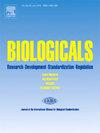The past, present and future of blood plasma fractionation
IF 1.5
4区 生物学
Q4 BIOCHEMICAL RESEARCH METHODS
引用次数: 0
Abstract
Edwin Cohn, appointed to the Harvard Medical School in 1920, was commissioned by the United States military in 1940 to develop a stable albumin solution to treat blood/plasma loss from battlefield injury. Albumin was first produced at the Harvard pilot plant using Cohn's five variable, ethanol precipitation process which was rapidly transferred to private industry for industrial manufacture. For the past decades IgG has been used to treat multiple conditions and has become the industry driver whilst albumin is now a low-price commodity. The development of purification techniques, particularly chromatography, spurred the manufacture of coagulation factors for haemophilia and other proteins from Cohn fractions, leading to the current, unique roster of multiple, essential, plasma-derived medicines. The major cost in fractionation is for plasma, making recombinant and other non-factor alternatives a challenge for the industry. Plasma-derived haemophilia therapies are largely redundant in Western economies, although other products, including prothrombin complex, alpha-1 anti-trypsin, fibrin sealant, provide essential treatments. The established industry is also challenged by potential alternatives to IgG. Despite the plethora of alternative manufacturing technologies, Cohn fractionation in combination with “upstream” harvesting of other proteins through other technologies and “downstream processes” which incorporate unit operations for virus safety is the global industry standard.
血浆分离技术的过去、现在和未来
埃德温·科恩(Edwin Cohn)于1920年被任命为哈佛医学院(Harvard Medical School)教授,1940年受美国军方委托,开发一种稳定的白蛋白溶液,用于治疗战场受伤造成的血液/血浆流失。白蛋白最初是在哈佛试验工厂使用科恩的五变量乙醇沉淀工艺生产的,该工艺很快被转移到私营企业用于工业生产。在过去的几十年里,IgG已被用于治疗多种疾病,并已成为行业的驱动力,而白蛋白现在是一种低价商品。纯化技术的发展,特别是色谱法的发展,刺激了血友病凝血因子和其他蛋白质的生产,从而产生了目前独特的多种基本血浆来源药物。分离的主要成本是血浆,这使得重组和其他非因素替代品成为行业的挑战。血浆来源的血友病治疗在西方经济体基本上是多余的,尽管其他产品,包括凝血酶原复合物,α -1抗胰蛋白酶,纤维蛋白密封剂,提供必要的治疗。现有行业也面临着IgG的潜在替代品的挑战。尽管有大量的替代制造技术,但Cohn分馏结合其他技术的“上游”收获其他蛋白质和“下游工艺”(包括病毒安全单元操作)是全球行业标准。
本文章由计算机程序翻译,如有差异,请以英文原文为准。
求助全文
约1分钟内获得全文
求助全文
来源期刊

Biologicals
生物-生化研究方法
CiteScore
3.70
自引率
0.00%
发文量
39
审稿时长
48 days
期刊介绍:
Biologicals provides a modern and multidisciplinary international forum for news, debate, and original research on all aspects of biologicals used in human and veterinary medicine. The journal publishes original papers, reviews, and letters relevant to the development, production, quality control, and standardization of biological derived from both novel and established biotechnologies. Special issues are produced to reflect topics of particular international interest and concern.Three types of papers are welcome: original research reports, short papers, and review articles. The journal will also publish comments and letters to the editor, book reviews, meeting reports and information on regulatory issues.
 求助内容:
求助内容: 应助结果提醒方式:
应助结果提醒方式:


